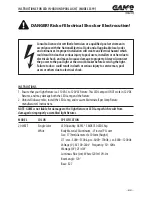
15
ixi gas pool and spa heater
Installation Manual
14
ixi gas pool and spa heater
Installation Manual
• For ease of access, remove the rear and top panels.
a
Loosen the two screws securing the air orifice and
screen in place. Remove the air pressure switch and
gas valve hose from the air orifice.
b
Remove the air orifice, separate and dispose of
the orifice screen.
Air Orifice
Air Orifice
Adapter
75 mm
(3") PVC
e
f
c
d
Marker
c
Align the orifice adapter with the orifice tabs and secure
with four screws.
d
Dry fit the 75 mm (3’) PVC tubing into the orifice
adapter. Mark screw hole locations with a pen. Remove and
drill pilot holes in the PVC. Fit the PVC into the orifice
adapter, align the holes and secure with four screws
e
Reinstall the air orifice and air hoses.
f
Install the new rear panel over the PVC and secure with
four screws.
4.3.3
Exhaust Venting
When the IXI heater is installed indoors or in an
outdoor shelter the vent pipe sizing must be in
accordance with the specifications listed in
Table 2.
CODES*
US
National Fuel Gas code ANSI Z223.1 (NFPA 54)
AUS/
NZ
IAPMO Oceana Standard for Gas Pool Heaters, AS/NZS
5263, AS5601 and/or Authority Having Jursidiction (AHJ)
STATIC
PRESS.
STACK
TEMP.
TERMINATION
LOCATION
PIPE SIZING
MAX
RUN
LENGTH
†
MATERIAL
MODEL PIPE
SIZE
Negative
High
Roof
(Vertical Termination)
200
150 mm
(6
″
)
11 m (35
′)
Aluminum
inner pipe.
Galvanized
outer pipe.
370
200 mm
(8
″
)
*Ensure that you are referencing the latest edition and pay special attention to the
chapter addressing “venting of equipment”
†
For each elbow installed, reduce the run length by 3.6 m (12’).
If a vent run
is required that will exceed a total equivalent length of 11 metres (35’), a draft
inducer or external fan will need to be added to the system.
If a vent run is required that will exceed a total equivalent length of 11 metres (35
ft), seek the assistance of a Registered Professional Engineer for proper design of
indoor venting systems.
Table 2.
Vent Pipe sizing Requirements
WARNING
Vent pipe materials, sizing, and installation must be
as required by the National Fuel Gas Code NFPA 54/
ANSI Z223.1 or Australia Standard for Gas Pool Heaters,
AS/NZS 5263, AS/NZS 5601 Gas Installations as
applicable by local code. Undersized pipe can result in
inadequate venting and oversize pipe can result in vent
condensation. Improper selection of vent pipe material,
incorrect sizing of the pipe, and incorrect installation of
vent piping can result in release of combustion products
to the indoors. This can cause serious injury or death by
Carbon Monoxide poisoning or asphyxiation.
WARNING
Improper installation or maintenance can cause nausea
or asphyxiation from carbon monoxide in fl ue gases
which could result in severe injury or death. For indoor
installations, as an added measure of safety, AstralPool
strongly recommends installation of suitable
carbon monoxide detectors in the vicinity of this
appliance and in any adjacent occupied spaces.
Incorrect design and installation of heater vents and
ducts can result in personal injury, damage to property,
or death. To avoid such hazards, the heater must
be installed only by a qualifi ed professional service
technician.
• STATIC PRESSURE - NEGATIVE:
Appliance
operates with a negative vent static pressure, a
vent gas temperature that avoids excessive
condensate production and will vent vertically
terminating at the roof. Termination must pass
through a properly installed and approved roof
jack, a properly sized storm collar and a listed vent
cap. See
Figure 4.
• Do not
terminate heater vents near air conditioning
or air supply fans which could pick up exhaust flue
products, such as carbon monoxide and other
hazardous effluent, and return them inside the
building.
• Vent pipe type and material must be carefully
selected and depends on the type of installation.
• Do not
locate the vent terminal where exhaust
flue products could strike against building
materials and cause degradation.
• Vent opening should be well away from
landscaping or other obstructions that would
prevent free air flow to and from vent terminal.
• Do not
terminate vent under decks, stairs, or car
ports.
• Do not
use the appliance to support the vent
pipe.
• Vent piping must be supported with no low spots
or sagging which could allow condensate to
collect.
• Install the vent pipe so it can expand and contract
freely with temperature changes.
• Do not
run the heater vent into a common vent
with any other appliance.
• It is recommended that vent runs over 5.5 m
(18’) be insulated to reduce condensation. Use
a condensate trap in the vent run close to the
heater, especially in cold climate installations.















































